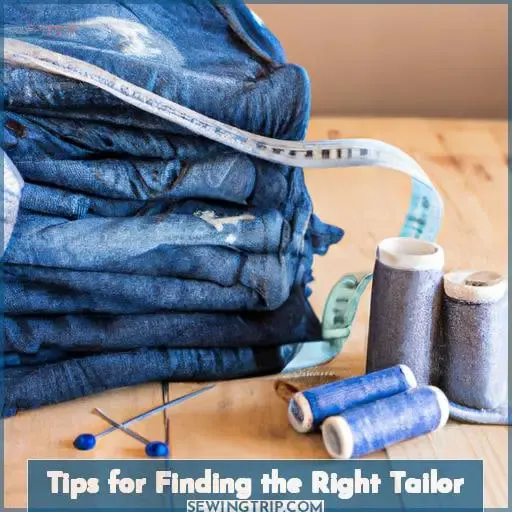This site is supported by our readers. We may earn a commission, at no cost to you, if you purchase through links.
Hemming jeans is an important alteration for many. It’s a simple task that can be done by yourself or a professional tailor, and the cost varies. To save money, hemming your own jeans at home takes as little as few minutes or over an hour; all you need are basic tools like scissors and thread! If you’re looking for more customised results, hiring a professional tailor may make sense – they have experience creating perfect hemlines tailored to your needs. Let’s explore how much it costs to hem jeans both professionally and DIY-style. That way, no matter your budget, style preferences and time restrictions, there’s something for everyone!
Table Of Contents
Average Prices for Hemming Jeans
Knowing the average cost of hemming jeans can help you budget and plan for a successful alteration. Professional tailors typically charge between $15-$30 to alter pants, depending on the fabric chosen, thread selection, as well as other options such as raising or lengthening the hemline. When doing DIY alterations at home, it’s important to consider pinning techniques and ironing methods to achieve desired results. A sewing machine may be used, but have a measuring tape handy when cutting excess material off from hems or seams.
Dry cleaners often offer alteration services, but their prices tend to be higher than those of independent tailors. However, they do provide convenience if time is an issue. To get reasonable prices with quality workmanship, seek out a well-reputed tailor who has experience in altering jeans specifically. This way, you’re sure that your garment will fit perfectly after making adjustments!
Steps for Hemming Your Own Jeans
You can save money by hemming your own jeans! It’s easier than you might think. Only a few simple steps are required.
Try them on to determine the desired length. Measure and mark how much fabric needs to be cut off, then rip or cut it away.
Fold up the material at the bottom of each leg where you want them hemmed and pin it in place.
Sew with a straight stitch setting for best results.
With practice and patience, soon you’ll be able to achieve professional-level hems from home!
Step 1: Try on Your Jeans
Put on your jeans and get ready to customize the perfect fit! Finding the right fabric, choosing thread, selecting needles, measuring length for a hemline that’s just right – these are all important steps. Depending on how much fabric you need to take off from each leg and whether or not it is part of a wedding dress will determine what size of the hem should be. When pressing creases into place before sewing begins, it helps ensure an even pair of perfect pants when finished. With some practice, you’ll soon master this look with ease. But don’t forget to factor in costs associated with finding materials needed as well as any alterations professionals may charge if you’d rather leave it up to them!
Step 2: Measure and Mark
Once you have the perfect fit in sight, it’s time to measure and mark the hemline for a truly customized look! You’ll need good quality thread that matches your fabric, as well as a tailor’s tools like an ironing board and steam iron.
Fold up extra fabric along each side of the leg until they hit the desired length. Secure them with pins, then sew with a standard straight stitch setting. Hand-sewing works with thicker fabrics like denim, but color thread matching can be tricky without professional help.
With patience and practice, anyone can master alterations. Just remember not to cut off too much fabric; it’s better to start small than end big when hemming.
Step 3: Cut and Rip
Taking the scissors to your fabric can be intimidating, but with a steady hand and attention to detail you’ll have those jeans hemmed in no time!
The third step is cutting and ripping. Using a seam ripper or sharp scissors cut along the existing hem of your pants.
Next, use the seam ripper again (or just pull gently) to remove any stitches that are still holding together what was once part of the original hemline.
Now you’re ready for new stitching! There are several ways to approach this step: from affordable alterations at home, using denim threading for quick repairs on quality seams, or even looking into more creative styles like frayed hems, which will give your home-hemmed pants an extra edge.
Just remember these tips when tackling Step 3: Cut and Rip – it’s an important part of creating beautiful finished garments!
Step 4: Fold and Pin
Now that you’ve cut and ripped, it’s time to fold and pin your jeans – are you ready for the next step? This is where precision matters most. To ensure a clean finish, fold up the old hem until it reaches your desired length. Use a ruler or measuring tape to measure from the bottom of the folded-up hem to just above where you want your new hemline – make sure this measurement is consistent on both legs! Once measured, double-check before folding down again and using straight pins evenly spaced around each leg (about every 1-2 inches) so they don’t slip while sewing.
If repairing flaws in existing hems or altering sizes with different inseams, selecting thread color can be important – choose one that blends well with fabrics but also matches any visible stitching details like topstitching or contrast seams if present; depending on fabric weight & texture, there might not be many options available!
Double-fold hems are common for heavier materials such as denim, which require added strength at stress points like cuffs/ankles. Determine how much extra fabric you’ll need based on the original length of the pant legs plus an additional inch for seam allowance when cutting excess material away from the raw edge after folding up into place along the crease line created during the first fold-over process mentioned earlier.
Also consider turn-around time: Professional tailors may offer quicker service than DIY methods, but cost more money upfront due to the expertise needed.
Technical considerations aside, hemming pants yourself can become an enjoyable hobby once mastered, and opens up possibilities by adapting pre-existing wardrobe pieces, further enhancing their fit.
Step 5: Sew
Now it’s time to get out the sewing machine and start stitching up your jeansu2014you’ve almost reached the finish line! Before you begin, make sure that your fabric is ironed flat so that there are no wrinkles or puckers. Double-check that you’ve threaded all of your needles with a strong thread color matching the pantsu2019 material for best results.
When picking stitches, use straight stitch settings on most fabrics such as cotton and linen; however, if working with denim or leather materials, opt for a zigzag stitch setting to secure seams better.
To ensure proper length when hemming women’s skirts or bridesmaids’ dresses, be sure to wear high heels during fittings. Press seams at bottom of pant legs using an iron set at low temperature, with little money involved in alteration services.
With practice and patience, you can master this skill, making perfect fitting pants every time!
Tips for Finding the Right Tailor
Finding the right tailor for your project is essential. Do your research: look into tailors in your area and ask friends/family for recommendations. Then check their experience with hemming jeans specifically.
Get a quote from them, including details such as how much it’ll cost to hem jeans and what type of techniques they use for altering garments like this.
Finally, check out the quality of the finished product before you leave. Make sure the hemlines are even and look professional!
Tip 1: Research Tailors in Your Area
To find the best tailor for your project, research experts in your area who specialize in alterations and custom-made clothing. Take into consideration measuring guidelines, fabric types and thread colors needed for pattern matching. Ask around for recommendations from friends or family who’ve had their jeans hemmed. Check reviews and safety pins online. Make sure they’re experienced with hemming jeans specifically, so you can be sure the job is done right according to your preferences and measurements. This’ll save you time and money.
Researching local tailors thoroughly may take extra effort, but it’s worth it if you want quality results that fit perfectly.
Tip 2: Ask for Recommendations
Ask your friends and family who’ve had their jeans altered for the best tailor in town. You’ll be sure to get an expert recommendation that’s worth its weight in gold!
Not only can they save you money, but a good tailor will also help with fabric selection, ironing creases, matching thread colors, and double stitching.
For more intricate garments like bridesmaids’ dresses or wedding gowns, having the right tailor is essential, as additional time may need to be spent on custom-made clothing.
Hemming jeans doesn’t require any high-tech tools; it just takes practice and patience, plus some basic sewing supplies like a needle, scissors, and thread.
Finding the right specialist for alteration projects is key, so don’t forget to ask around before taking your pants into just anyone’s hands!
Tip 3: Check Their Experience
Check their experience in customizing jeans before trusting them with your hemming project – it can make all the difference! Look for a professional tailor or seamstress who has an understanding of fit and fabric selection, as well as access to tailoring tools. Quality assurance is also important when hemming jeans; ensure they’ve worked on bridesmaid’s dresses or garment alterations in the past. Knowing how experienced a tailor is will give you peace of mind knowing your project will be done right.
Ask about any references they may have for previous work and confirm the quality so you know what type of result you should expect from them when working on your own clothing items.
Tip 4: Get a Quote
Make sure you get a quote from your tailor or seamstress before hemming your jeans. Price comparisons between different tailors can help you find the most economical option. Ask questions about their sewing techniques, fabric choices, and hem styles to ensure you get the correct length. The average price for this service is usually around $15-$30, depending on location, materials used, turnaround time etc. Be sure to ask what’s included in the cost – materials and extra labour, such as hand-sewing or complex stitching techniques. Consider whether there are additional costs associated with different types of hems; e.g., turning up cuffs may cost more than simply shortening trousers at a straight line below knee level.
Do research ahead of time and ask plenty of questions about prices and services offered by tailors/seamstresses near you. You’ll be able to find one who can provide quality workmanship within an acceptable budget range!
Tip 5: Check the Hemline
Before you get your jeans hemmed, double check the length to make sure it’s exactly how you want it! Take into account factors such as choosing the right fabric and taking accurate measurements. If there’s an issue, consider finding alternatives or adjusting lengths. Deciding whether to have permanent hemlines added requires careful consideration of cost-effectiveness vs convenience when selecting fabrics and making adjustments for special occasions like bridesmaids’ dresses. There are several levels of fabric folds that affect cost to hem jeans; from basic alterations done by hand through simple sewing machines, up to more complex tailoring techniques for leather or denim that may require specialist tools and experienced tailors. They can work with delicate fabrics at high precision accuracy levels – all at different price points depending on time taken to complete.
Frequently Asked Questions (FAQs)
What kind of tools do I need to hem jeans?
Hemming jeans is a fun DIY project. You don’t need high-tech tools. All you need is a sewing kit, thick or heavy-duty needle and an iron. Select the right fabric before beginning – consider seam allowance and stitching methods when customizing styles. Iron the material beforehand for a straight line. With practice and patience, you’ll have professional-level hems on bridesmaids’ dresses, formal wear skirts or women’s jeans.
How long does it take to hem jeans?
Hemming jeans is a relatively easy alteration. It can take as little as a few minutes, although it may take over an hour depending on which method you choose. You don’t need any high-tech or specialty tools. Just use your standard sewing kit and some thick, heavy duty needles if hemming women’s jeans.
Alternatively, there are online tutorials for DIY kits and pressing techniques to help get the perfect hemline.
If you’re looking for more specialist help with gentle handy work – such as bridesmaid’s dresses or women’s skirts – then custom-made clothing from seamstresses and tailors is available at varying costs (which usually includes materials).
All this allows you to open up possibilities of adjusting existing wardrobe items with ease!
Can jeans be altered to fit petite sizes?
Yes, jeans can be altered to fit petite sizes! Choosing the right fabric and customizing styles is key to making sure your garment fits perfectly. You’ll need a tailor who specializes in petite sizing for this type of alteration – prices may vary from place-to-place so it’s important to do some price comparison beforehand.
Alteration options include taking up shorter legs or creating new hemlines on skirts, shorts, or women’s trousers. Ready-to-wear designer fashions are usually easier to alter than custom made pieces like bridesmaid dresses as they don’t require additional material costs and time-consuming tailoring techniques that come with enlarging garments more than one size too large.
Should I wash my jeans before hemming?
It’s a good idea to wash your jeans before hemming them. Machine-washable garments should be washed beforehand to account for any shrinkage. This washing technique is important when choosing a tailor and fabric. Certain materials may cost more due to complexity. Time expectations vary based on price comparison. Shortening length of pants or sleeves usually takes just minutes with a simple sewing kit if you do it yourself at home. Bridal gowns or costumes require more complex tailoring techniques and may take much longer, thus costing significantly more. Alterations open up possibilities for adjusting existing wardrobe. But all these tips depend on finding the perfect tailor selection!
Is it more expensive to alter women’s clothing than men’s?
Alterations for women’s clothing may cost more than men’s due to varying fabrics and trends. Tailoring a dress, skirt or blouse often involves top-stitched hems, fabric selection and quality assurance, which can increase costs. Bridesmaid dresses require time consuming tailoring, and wedding dress sizing is typically designed with alterations in mind, but still costly due to delicate fabrics like satins or silks. Denim jeans usually cost more to alter due to their heavy material, requiring a high-duty needle when hemming, by hand or machine – adding an extra layer of complexity for tailors who specialize in gender specific services.
Conclusion
In conclusion, hemming jeans is a great way to alter your wardrobe and create custom looks without breaking the bank. Costs can range from $15 to $30. You can also save money and time by hemming your own jeans. All you need is a few simple tools and some patience. With practice, you can get to a professional level of hemming.
An important tip: find the right tailor for your project. Ask around for recommendations and check their experience. Once you find the right fit, you can get a quote and check the hemline before committing. With the right tailor, you can have jeans that fit just the way you want them.









